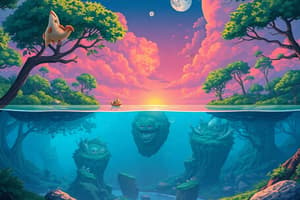Podcast
Questions and Answers
En una cadena alimentaria, los productores son organismos heterótrofos que elaboran su propio alimento utilizando la energía del sol.
En una cadena alimentaria, los productores son organismos heterótrofos que elaboran su propio alimento utilizando la energía del sol.
False (B)
Los consumidores primarios son carnívoros que se alimentan de otros consumidores primarios.
Los consumidores primarios son carnívoros que se alimentan de otros consumidores primarios.
False (B)
Los descomponedores, como las bacterias y los hongos, descomponen los organismos muertos liberando nutrientes de vuelta al ecosistema.
Los descomponedores, como las bacterias y los hongos, descomponen los organismos muertos liberando nutrientes de vuelta al ecosistema.
True (A)
Cada nivel en una cadena alimentaria se conoce como nivel geotrófico.
Cada nivel en una cadena alimentaria se conoce como nivel geotrófico.
En la transferencia de energía de un nivel trófico al siguiente, se pierde una porción significativa de energía en forma de luz.
En la transferencia de energía de un nivel trófico al siguiente, se pierde una porción significativa de energía en forma de luz.
Las cadenas tróficas son fundamentales para entender la interconexión de los organismos dentro de un ecosistema.
Las cadenas tróficas son fundamentales para entender la interconexión de los organismos dentro de un ecosistema.
Una disminución en la población de un depredador clave no afecta la cadena trófica.
Una disminución en la población de un depredador clave no afecta la cadena trófica.
El cambio climático y la contaminación pueden alterar gravemente el equilibrio de una cadena trófica.
El cambio climático y la contaminación pueden alterar gravemente el equilibrio de una cadena trófica.
Un ecosistema con mayor biodiversidad es menos resistente a las perturbaciones.
Un ecosistema con mayor biodiversidad es menos resistente a las perturbaciones.
Todas las cadenas tróficas acuáticas empiezan con algas como productoras.
Todas las cadenas tróficas acuáticas empiezan con algas como productoras.
Flashcards
Cadenas alimenticias
Cadenas alimenticias
Muestran la interconexión de organismos en un ecosistema.
Impacto de la biodiversidad
Impacto de la biodiversidad
Mayor biodiversidad hace que las redes alimentarias sean más resilientes.
Factores que afectan las cadenas alimenticias
Factores que afectan las cadenas alimenticias
Cambios en una especie pueden afectar toda la cadena.
Ejemplo sencillo de cadena
Ejemplo sencillo de cadena
Signup and view all the flashcards
Cadena alimenticia acuática
Cadena alimenticia acuática
Signup and view all the flashcards
Cadena alimentaria
Cadena alimentaria
Signup and view all the flashcards
Productores
Productores
Signup and view all the flashcards
Consumidores primarios
Consumidores primarios
Signup and view all the flashcards
Descomponedores
Descomponedores
Signup and view all the flashcards
Flujo de energía
Flujo de energía
Signup and view all the flashcards
Study Notes
Biological Concepts of Food Chains
- A food chain depicts the energy transfer through an ecosystem, illustrating feeding relationships among organisms.
- Producers (autotrophs) create their own food using light energy (photosynthesis) or other sources. Examples include plants, algae, and some bacteria.
- Consumers (heterotrophs) obtain energy by consuming other organisms. Consumers are categorized based on their position in the food chain:
- Primary consumers (herbivores) eat producers.
- Secondary consumers (carnivores) eat primary consumers.
- Tertiary consumers (carnivores) eat secondary consumers.
- Quaternary consumers (carnivores) eat tertiary consumers.
- Decomposers (e.g., bacteria, fungi) break down dead organisms, releasing nutrients back into the ecosystem, crucial for nutrient cycling.
- Each level in a food chain is a trophic level. Energy transfer between trophic levels is inefficient; a significant portion is lost as heat. This limits the length of food chains.
- Food webs, more complex than food chains, depict the interconnected feeding relationships among various organisms in an ecosystem.
- Food chains and webs represent fundamental ecological processes.
Types of Organisms in Food Chains
- Producers (plants, algae) transform light energy into chemical energy through photosynthesis.
- Herbivores (e.g., rabbits, deer) are primary consumers, feeding on producers.
- Carnivores (e.g., wolves, snakes) are secondary or tertiary consumers, consuming herbivores or other carnivores.
- Omnivores (e.g., bears, humans) consume both plants and animals.
- Decomposers (e.g., bacteria, fungi) break down dead organisms, returning nutrients to the ecosystem.
- Scavengers (e.g., vultures, crows) consume dead animals.
Energy Flow in Food Chains
- Energy flows from producers to consumers.
- Only approximately 10% of energy is transferred from one trophic level to the next. Most energy is lost as heat.
- Fewer energy resources become available at higher trophic levels, hence limiting the number of trophic levels.
- Biomass, the total mass of organisms, also decreases along the food chain.
Importance of Food Chains in Ecosystems
- Food chains illustrate the interconnectedness of species within an ecosystem.
- Food chain knowledge helps predict effects of ecological disruptions or interventions.
- They visualize energy and nutrient movement in an ecosystem.
Factors Affecting Food Chains
- Alterations in one species' abundance can cascade, affecting the entire food chain. Loss of a key producer or consumer can have significant consequences.
- Pollution, climate change, and habitat loss disrupt food chain balance. These factors can have negative consequences including population imbalances, extinction, and biodiversity loss.
- Availability of resources (water, sunlight, nutrients) and environmental factors (temperature, rainfall) influence food chain stability.
Biodiversity and Food Chains
- High biodiversity makes food webs more resilient.
- A diverse array of producers, consumers, and decomposers creates a more adaptable food web, ensuring essential ecosystem functions if some species decline or disappear.
Examples of Food Chains
- A simple example: Grass → Grasshopper → Frog → Snake.
- A more complex example: Phytoplankton → Zooplankton → Small fish → Large fish → Shark.
- Aquatic food chains often involve algae and plants as producers.
Studying That Suits You
Use AI to generate personalized quizzes and flashcards to suit your learning preferences.


